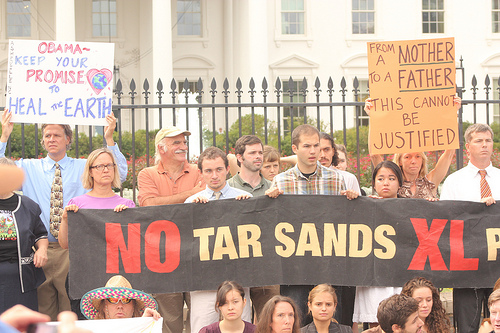
The keys to stopping Keystone XL
If you’d have asked me in the fall of 2009, when Friends of the Earth was first contemplating going all in on a campaign to stop the Keystone XL pipeline, whether I thought we could force President Obama to reject TransCanada’s application for a permit, I would have said, “probably not, but we’ll put up a good fight.”
At the time, the environmental movement was fractured and demoralized after having tried and failed to advance meaningful legislation to address the climate crisis following the election of a Democratic-controlled Congress and of a new president who had promised to lead on clean energy and climate solutions. The money and lobbyists of dirty energy industries, from oil to coal to nuclear to corporate agribusiness, had corrupted the process so deeply that the final bill was riddled with giveaways and loopholes; it would have taken us further back than forwards.
The victory we won on Keystone XL was against long odds, and it’s important to reflect on its lessons in order to build on the hope and momentum it gives to the climate and progressive movements. These are the lessons that I think are most important.
Never assume you have a friend in the White House, political party notwithstanding
We approached this fight armed with the promises President Obama had made during his campaign and upon his inauguration — such as to lead “the generation that finally frees America from the tyranny of oil” and to “work tirelessly to … roll back the specter of a warming planet” — but unwilling to take the president at his word. Indeed, we’ve seen many unacceptable actions from the Obama administration that betrayed these promises: opening up more of our coastlines to oil drilling, trumpeting the dirty lies of the coal industry, squashing ambition and equity in international climate negotiations and trashing life-saving smog protections.
To stop the Keystone XL pipeline, we knew we would have to compel the president’s “no.” We had to demonstrate that a lot of people were fired up and determined to hold him accountable — that we wouldn’t go away, and indeed would keep coming back in bigger and bigger numbers, until he made the right decision. (When I use “we” from here on out I’m referring to the broad coalition, including indigenous, environmental, climate, landowner, national and state progressive, union, direct action, faith and many other groups and categories of activists who joined the fight.)
Becky Bond, political director of CREDO Action, got it right in her email to CREDO activists on the pipeline rejection:
President Obama didn’t reject Keystone XL because he wanted to. Or because he thought it was the right thing to do. Or because he thought it would help his reelection campaign. He rejected it because you made him do it.
Grassroots pressure is power
If assuming the president was not an automatic ally was the winning outlook, applying sustained and creative grassroots pressure was critical to the winning strategy.
In his post on the grassroots strategy behind the Keystone XL fight, 350.org communications director Jamie Henn aptly summarized that, far from relying on “inside the beltway compromises and back-room deals”:
The campaign was successful because of its focus on grassroots mobilization, including the use of nonviolent civil disobedience, genuine and straight-forward communication with the public, a distinctly coalition approach, and a sharp political strategy that consistently turned up the pressure on President Obama.
Grassroots resistance to the Keystone XL pipeline began with the people who had the biggest immediate stakes. Indigenous communities living with the devastating impacts of the tar sands industry sounded the alarm and led the fight from day one. As TransCanada began bullying landowners along the pipeline’s route from Montana to Nebraska to Texas, and as a flurry of spills from existing tar sands oil pipelines underscored the Keystone XL’s danger, concerned residents in America’s heartland began rising up, too. It was people far from seats of privilege in Washington, D.C. — people like Kandi Mossett and Francois Paulette, Randy Thompson and Cindy Myers, David Daniel and Bryan Parras — who were the spark behind and the moral compass for the escalation that proved pivotal in August.
Grassroots mobilization took off nationwide with the peaceful sit-ins organized by Tar Sands Action in August. President Obama and his political operatives could have hardly avoided noticing the national news headlines generated by the 1,253 individuals who planted their bodies in front of the White House gate and got arrested day after day for two weeks. As Bill McKibben recapped, “By protest’s end, the political world was well aware that this had become Obama’s central environmental test between now and next year’s election.”

In the end, as Friends of the Earth’s president, Erich Pica, said in his response to the president’s rejection of the pipeline permit, “Sustained grassroots pressure aimed at holding the president accountable to the public interest proved more powerful than all the lobbyists and campaign cash the oil industry could muster.”
Challenge business as usual, a.k.a. the corrupting pull of the polluter lobby
While the pipeline permit was “presidential,” the State Department was in charge of actually analyzing the potential environmental impacts of the project and recommending a course of action. Just as surely as we couldn’t assume we had an ally in President Obama, we couldn’t assume that we were working with a State Department committed to doing its job for the public, namely conducting a rigorous, independent and science-based review.
Investigating and exposing how Big Oil bias and cronyism was corrupting the environmental review process was one of Friends of the Earth’s unique contributions to the Keystone XL campaign. Our eyebrows were first raised by the shoddy draft environmental impact statement that the State Department — or rather its contractor Cardno Entrix — had released in April 2010. Our determination to dig further was steeled when Secretary of State Hillary Clinton made the wildly inappropriate remark in October 2010 that she was “inclined” to approve the pipeline even though the environmental review was not yet complete.
Then, we learned that TransCanada’s lead Keystone XL lobbyist in Washington, Paul Elliott, just happened to have been a top aide on Hillary Clinton’s presidential campaign. In December 2010, we joined with the Center for International Environmental Law and Corporate Ethics International to file a Freedom of Information Act request with the State Department requesting all communications between Elliott and State Department employees. After stonewalling from the State Department, we, represented by Earthjustice, filed suit. We finally began receiving the documents just as the sit-ins at the White House were wrapping up.
Suffice it to say the documents proved our suspicions were warranted. (You can read up on the nitty-gritty of the scandal here.) A State Department official’s flagrant cheering of “Go Paul!” made front-page headlines. News outlets like Think Progress and the New York Times exposed the stunning conflict of interest evident in TransCanada hand-picking a contractor in Cardno Entrix that called TransCanada a “major client.” State Department spokespeople and even Secretary Clinton faced repeated grilling from journalists. Members of Congress led by Senator Bernie Sanders (I-Vt.) and Representative Steve Cohen (D-Tenn.) stepped in and took action to hold the State Department accountable, inciting the launch of an inspector general investigation.
This scandal kept the Keystone XL pipeline in the news and on front pages at a crucial time — just after the White House sit-ins were completed and the #noKXL movement was in need of a show of momentum.
The bottom line
The bottom line is that we cannot expect to go through the motions of a bureaucratic process hopelessly influenced by Big Oil or any moneyed and access-rich polluter lobby and win – and that we don’t have to accept business as usual as the inevitable state of play. When government isn’t serving the public interest, it’s our job to expose it and challenge it. In this case, delegitimizing a corrupted review process worked in tandem with grassroots mobilization to force President Obama’s intervention and, ultimately, his rejection of the pipeline.
Onward
The Keystone XL pipeline is rejected, and we won a huge victory that is already sending a chill through the tar sands industry. But fifty or even five years from now it will have been a small and fleeting victory unless we can apply its lessons and capitalize on the surge of energy it has injected into the climate movement.
From mingling (and getting arrested) with the people who invested their time, money and sweat into planting their bodies at the White House in August, I can say that what motivated many was not just the goal of stopping one pipeline — but the goal of forging a movement capable of winning real and lasting climate solutions.
Moving forward, I couldn’t agree more with Jamie Henn that, “we pipeline protesters need to remain bold, grassroots risk-takers.”
Because, as Grist writer David Roberts echoes:
Greens can never match the money behind fossil fuels, but as the Keystone XL fight has shown, they can out-organize and outmaneuver their opponents when they put their bodies and sweat into it. As long as they ignore the ‘experts,’ they’ll be fine.
Yes, the Keystone XL pipeline is a corpse that TransCanada will keep trying to resurrect, and we must remain vigilant and do all we can to ensure no part of it is ever built. Yes, the path ahead remains steep. But I am hopeful that through this fight the climate movement has learned what it takes to climb, and how to do it together.
Related Posts
Ways to Support Our Work

Read Latest News
Stay informed and inspired. Read our latest press releases to see how we’re making a difference for the planet.

See Our Impact
See the real wins your support made possible. Read about the campaign wins we’ve fought for and won together.

Donate Today
Help power change. It takes support from environmental champions like you to build a more healthy and just world.